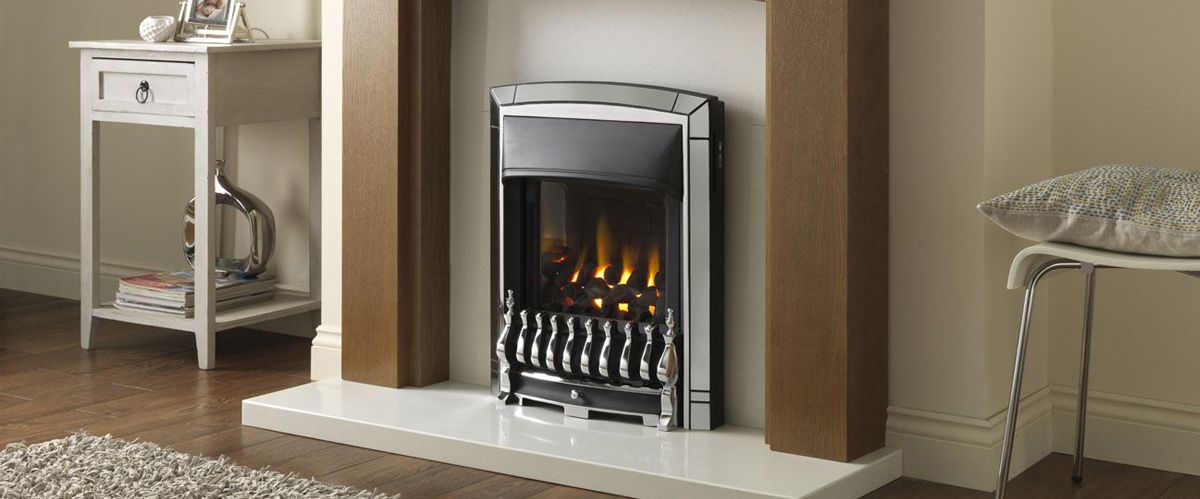
Choosing the right gas fire for your home can be a daunting task, this guide is designed to help you understand the different types of gas fires available and to help you ensure you choose the right fire. There are gas fires available for virtually all homes including modern properties without a chimney or flue. Whether you are looking for a replacement, high efficiency gas fire or a contemporary model that will be fitted raised up on the wall, the information below should help you in your quest to locate the perfect fire!
Inset Gas Fires
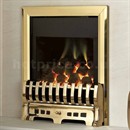
Inset gas fires or 'living flame fires' have been popular since their introduction around 25 years ago. Designed to simulate a real coal fire, when inset gas fires were first released, emphasis was mostly given to how the fires looked rather than their efficiency and these fires still have the reputation of using a lot of gas whilst losing most of the heat produced up the chimney or flue. Whilst open-fronted, inset gas fires will lose around 40-50% of the heat up the flue, modern versions of this type of fire will use a lot less gas than they used to and heat outputs can reach over 4kW on many models.
There is a new range of open-fronted, inset gas fires now available which use a baffle to reduce the outlet. When fitted into a standard chimney, these fires have improved efficiency of around 70% whilst still retaining the beauty of a open-fronted, living flame.
If you are looking for a new gas fire to replace an existing model you have, the chances are that the opening size you currently have will be the same that is required for a new fire. Most of the inset gas fires offered on the Hotprice.co.uk website are standard, 16" models and it is a universal opening of approximately 410mm wide x 560mm high. There used to be a large number of 18" and 22" gas fires offered but due to manufacturers concentrating on making more efficient fires, many of these fires have now been discontinued. If you do have a existing fire that is not a standard 16" size, a replacement back panel or slips to reduce your opening size may be needed.
Recently, demand for glass-fronted gas fires has gone up dramatically. Glass-fronted fires will offer improved efficiency - using less gas whilst offering the same (if not higher) heat output than most open-fronted models. The reason for this is due to the fact that on a glass-fronted gas fire, fumes are unable to enter the room and therefore the flue outlet is smaller than on a open-fronted gas fire. This results in the gases staying around the fire bed longer giving more heat whilst using less gas. Glass-fronted, inset gas fires boast net efficiency of up to 89%!

Hole-in-the-Wall Gas Fires
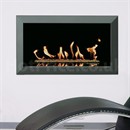
Hole-in-the-Wall gas fires give you the opportunity to fit a striking, focal point in your home without the need to have a hearth protruding into the room taking up valuable space. A popular choice on modern inspired interiors, hole-in-the wall gas fires are available in a vast range of sizes and designs and both open and glass-fronted. Due to the depth required and emissions produced, hole-in-the-wall gas fires are mostly suited to Class 1 (real chimneys).
Due to the size of these types of fires, many models offer a heat output far greater than inset gas fires. The glass-fronted, Gazco Studio fire pictured is available in two sizes with a maximum heat output of 6.5kW! This type of fireplace will require considerable building work such as creating the correct opening higher up the chimney (often a lintel will need to be fitted) and once fitted, the wall will need to be plastered. We would always recommend using a Gas Safe installer who is familiar with fitting hole-in-the-wall gas fires.

Balanced Flue Gas Fires
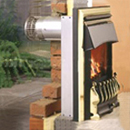
The most popular choice now for homes without a chimney or flue, Balanced Flue Gas Fires are always glass-fronted and the fumes are taken horizontally through an external wall via a twin skinned pipe. The glass-front means that there is no need for a fan unit like you would get on a Powerflue gas fire and in most cases, there is no need to connect to a electricity supply. Balanced flue gas fires offer improved efficiency and silent operation. They are available in both inset (fitted into a fireplace), hole-in-the-wall plus there are a small number of models which can simply be hung on to an external wall.
Hole-in-the-Wall balanced flue gas fires will require a false chimney breast to be built to accommodate the appliance depth. Inset balanced flue gas fires require a standard cut-out in the back panel of the fireplace surround and it is common for them to be fitted on to a flat wall. The brickwork behind the fire is removed and the fire 'engine' is inset into the cavity of the wall.

Powerflue Gas Fires
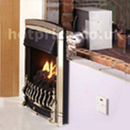
Anyone looking for a open-fronted gas fire but who doesn't have a chimney or flue will need to choose a Powerflue gas fire. Working in the same principle as a Balanced Flue gas fire, Powerflues expel the fumes produced through an external wall in a horizontal pipe. As this type of fire is open-fronted, a electronically driven fan unit is fitted at the end of the pipe which pulls the fumes outside. Powerflue fires will not work if there is a power cut and the noise of the fan can sometimes be apparent.
Most Powerflue gas fires are inset models which are designed to be fitted into a standard fireplace opening. Designs are available in both traditional or contemporary and installation will cost more on this type of fan as there will be additional work needed with putting a hole through the wall and connecting the fan system.

Flueless Gas Fires
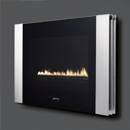
Whilst still classed as new technology in the UK, flueless gas fires have been extremely popular in other countries for some time. Flueless gas fires allow homes without a chimney or flue to enjoy a real flame gas fire - even fitted on a internal wall. Safety is obviously peoples first concern when looking at a flueless appliance. Many gas fire installers are still concerned about a gas fire that does not require a flue but this type of appliance has numerous safety devices fitted to ensure that the fire will automatically cut-out should the sensors pick up on fumes entering the room.
Flueless gas fires do have a minimum room size requirement dependant on the model chosen and all require an air vent to be fitted into the room. The flames on a flueless gas fire won't be as high as on a normal flued gas fire. They are available as inset, hang-on-the-wall or hole-in-the-wall designs.

Gas Fire Control Options
The way you light a gas fire has now become much easier with the introduction of several new control options. Whilst still the most common type is a manual, Piezo control located at the bottom of the fire, many customers are looking for gas fires that allow them to operate it without the need to get down on their hands & knees! Many models of gas fires are now available with several control upgrades.
Manual Control: Manual control gas fires feature a control knob and often a separate ignition button at the bottom of the appliance. The bottom section of the fret is moved to access the controls and the control knob normally has full/half settings.
Slide Control: Slide control allows the user to switch the fire on and gives full control of the flame height via a small lever located at the top right hand side of the trim. On fires such as Flavel Fires which have this feature, the slide control option is powered by a a AA battery and does not require connection into a mains electricity supply. This is the control option we recommend as the best for elderly customers.
Remote Control: A hand-held remote control is now a popular option on gas fires - especially on hole-in-the-wall designs where it is often a standard feature. There are two variants of remote control. Some manufacturers use a permanent pilot option which requires you to manually light the pilot light before you can control the flame height with the remote control. Many users of this type of control leave the pilot light on during the colder months which is perfectly safe to do so. Gas fires that feature a fully sequential give you total control of control of the fire including on/off and flame height adjustment. Fires that have a sequential remote control are either battery operated (in both the handset & appliance) or require mains electric connection. Some remote control options even offer thermostatic control allowing you to set the control and the fire switches itself down once the room has reached the desired temperature.
Using a remote control on a gas fire can be quite fiddly and normally requires two buttons to be held in at the same time to switch the fire on and also to increase the flame height. We therefore do not normally recommend this type of control for elderly users. The sequence a remote needs to carry out will take up a lot of power and on the battery operated models, if using the fire several times a day, the batteries will need changing regularly.

Gas Fire Installation
The installation of any gas appliance must be carried out by a Gas Safe registered person. Failure to install appliances correctly could lead to prosecution. It is in your own interest and that of safety to comply with the law. The installation must also be in accordance with all relevant parts of the Local and National Building Regulations where appropriate, the Building Regulations (Scotland Consolidation) issued by the Scottish Development Department, and all applicable requirements of the following British Standard Code of Practice:
1. BS 5871 Part 3 Installation of Decorative Fuel Effect Gas Fires
2. BS 6891 Installation of Gas Pipework
3. BS 5440 Parts 1 & 2 Installation of Flues and Ventilation
4. BS 1251 Open fire place components
5. BS 715 / BS EN 1856-2 Metal flue pipes for gas appliances
6. BS 6461 Part 1 Installation of Chimneys and flues
7. IS 813 : 1996 Domestic Gas Installation (Republic of Ireland)
Proof that your gas fire has been fitted by a registered person and to manufacturers instructions will be required in the event of a warranty claim.
Gas Fire Servicing and Maintenance
Gas fires will require annual servicing by a registered person to ensure that they continue to work correctly and safely. This is also a condition of manufacturers that offer a extended guarantee scheme. The service should include visually checking the chimney and fire opening for accumulations of debris and a smoke test to check for a positive up-draught in the chimney. The condition of the fuel effect should be checked and if necessary the whole set should be replaced with a genuine replacement set. After any servicing work a gas tightness check must always be carried out. Servicing normally includes replacing the oxy-pilot assembly (part of the ignition).